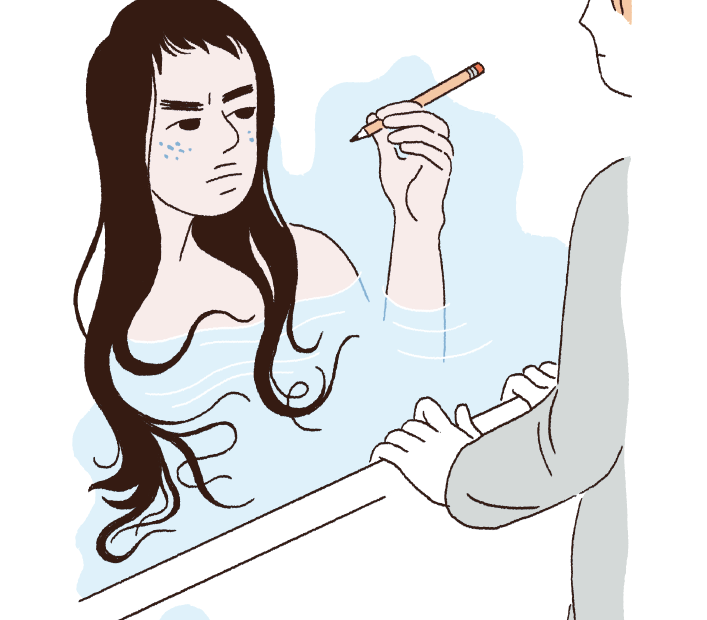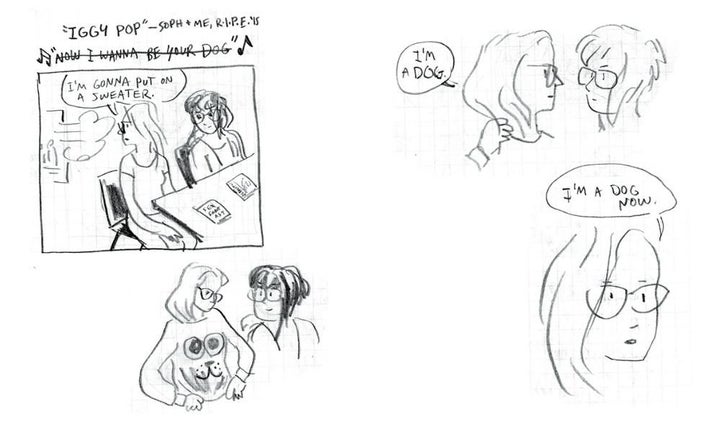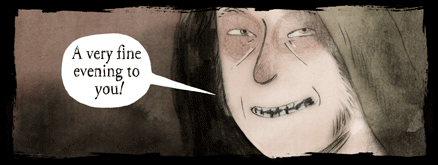
A portion of "Swim Thru Fire."
“Swim Thru Fire,” a serialized comic featured on Penguin Random House Canada’s Hazlitt magazine, is today’s best argument for comics on the Web.
The series, now in its fifth installment on the site, centers around Ada, a mermaid who lives underwater among others of her kind, undulating plants and large whales. She makes contact with the surface when she rescues a woman researcher who’s been thrown overboard. The story continues from there, both on the research boat and in the water, with co-creator Annie Mok’s writing and Sophia Foster-Dimino’s art laying down broad brushstrokes of setting, characterization and feeling.
When discussing their comic on the “Young Talk” podcast, Mok described the vision of the story as “loosely a retelling of The Little Mermaid,” Hans Christian Andersen’s classic tale of a mermaid who gives up her identity to obtain a human soul for the love of a prince. In the comic, the mermaids are there, but the prince becomes a female researcher.
“I identify as a trans woman; all my protagonists for my fictional work are trans people, usually trans women,” Mok explained to The Huffington Post in an email. “There have been a lot of trans readings of The Little Mermaid, and certainly Hans Christian Andersen was a queer person who had been abused. I identified with the hurt, desire and outsider feelings he put into that story.”
The series would be a masterpiece in any form, but what strikes immediately is the framing: one long, continuous panel that the reader must scroll down to read. It’s an effect that ties the art form to its digital home; the act of moving down the page conveys the depth, both literally and figuratively, of the story at hand. One scrolls further down, unsure of how far from the beginning they are, curious about how deep it might go -- not dissimilar to a plunge into the cold sea.

To describe her and artist Foster-Dimino’s dual efforts, Mok turns to other known collaborators. “Jeff Parker compared his comic book scripts for Steve Lieber to what silent movie scripts might be like, and I do the same,” she said, recounting how she gives Foster-Dimino “stage directions with notes on what the characters are thinking and feeling.” From there, Foster-Dimino draws the strip.
“I think of how Billy Strayhorn wrote and arranged for Duke Ellington, and then Duke and Johnny Hodges and the rest of Duke’s orchestra fleshed the song out, improvised, and made it real,” Mok said.
Mok’s background as a comic artist helps as well. “Our process maybe involves more back-and-forth than the standard writer-artist pipeline used in mainstream comics, but I think the rhythm we've come up with is much better for both of us in terms of creative payoff,” Foster-Dimino wrote to HuffPost in an email.
“She cooked up the notion to keep the ocean parts very flowing and open, and to make the parts on the boat all hard edges and constrictions,” Mok said of Foster-Dimino. “Like any story, it's a story in part about contrasts, and her choices draw out and build upon nuances suggested in the scripts.”

"Iggy Pop," a short comic created by Mok while she and Foster-Dimino were at the Rhode Island Independent Publishing Expo.
Foster-Dimino noted that this collaboration was the first one she's worked on specifically for the Web. “Many people have loved the scrolling, and it’s been incredibly fun for me as an artist to solve compositional problems when you have no vertical boundaries.”
In “Swim Thru Fire,” its digital home is not merely an afterthought or at odds with the story’s structure; it works directly with it.
The comic is one example of how artists can use digital screens to their advantage. “I’d like to see more online platforms offer legitimate, well-paying opportunities for cartoonists, and I’d also like to see cartoonists push what can be done on the Web,” Foster-Dimino said, noting that comics are seldom outfitted for a smartphone screen, typically looking better on a tablet or computer. She admires fellow artist Maré Odomo for occasionally tailoring comics for mobile viewing, “since viewing images on a phone is a special kind of intimate experience."
"There is something about the space of a Web page that is uncanny, inherently ... because you don’t know when it will end. With a book, you know where you are,” Foster-Dimino added on the "Young Talk" podcast. "It’s something you can physically hold in your hands, you have control over it and shut it in your hands if it scares you ... Web comics have the power to be much more manipulative.”


GIFs from Emily Carroll's "Out of Skin."
Artist Emily Carroll, author of graphic story collection Through the Woods, is also known for producing Web comics that take advantage of digital spaces, using GIFs to add surprise and tension in a way that paper cannot. Clicking on a comic from Carroll’s homepage takes a reader to a black-background site, her creations front and center. At the bottom of each scroll, “next” buttons tell you that there’s more to come -- but there’s no telling what it could be, and for how long it will last. She cites fellow artist Jen Lee, creator of "Thunderpaw," as another creator using GIFs and online tools in innovative ways.
Carroll noted she draws faster on a tablet, "which means I can get mistakes out of the way quicker and correct myself more easily." In traditional work, "I can get very sloppy -- I smear ink a lot, I get fingerprints everywhere -- and when I mess up a drawing, I tend to get frustrated and scrap the entire thing."
Interestingly, Carroll doesn’t see the print versus digital dilemma as "an either/or situation" in the comic world. "There's things you can do online that would be impossible to do in print," she told HuffPost in an email. Online spaces are typically more accessible for artists in terms of publication and exposure -- it's faster and easier to share a link or a graphic online than to send them in the mail, or secure a spot selling them in-person at a convention.
This advantage becomes all the more significant when one considers the unlimited space online to host the typically untold stories from authors in marginalized groups. Mok noted that most of the comics she considers radical are found online or in self-published zines. Though these are a useful starting point, traditional publishing hasn't quite caught up. "Most small presses and even micropresses remain somewhat hidebound politically," Mok said in an email. "For example, the number of black cartoonists that have had books published by Fantagraphics and Drawn & Quarterly [two major comics publishers] can be counted on one or two hands."
Citing the alienating "R. Crumb mold for indie cartoonists as sad sack, angry misogynist white boys," Mok finds fewer radical voices in comics than in similar music and zine scenes. Despite the grim landscape, there's still hope: "I feel very excited about a number of voices," she said, listing the The Response, Sab Meynert, Cathy G. Johnson, Higu Rose and Aatmaja Pandya, to name a few, as some inspiring voices that challenge norms in the cartoonist world.
With "Swim Thru Fire," Mok and Foster-Dimino can also add their own names to that list.
Also on HuffPost:

